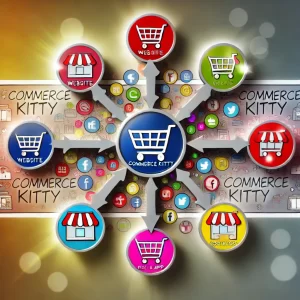The eCommerce industry is booming, with billions of dollars in transactions occurring every year. As more consumers shift their shopping habits online, competition among eCommerce businesses has never been fiercer. To stand out and achieve sustainable growth, having a strong eCommerce marketing strategy is essential.
In this guide, we will explore the most effective eCommerce marketing strategies that can help you attract more customers, increase sales, and build a loyal customer base.
1. Optimize Your Website for Conversions
Your eCommerce website is the foundation of your online business, so optimizing it for conversions is the first step in any successful marketing strategy. Without a website that is user-friendly, fast, and easy to navigate, potential customers will leave before making a purchase.
Key Tips for Website Optimization:
- Mobile Responsiveness: A large percentage of online shoppers use mobile devices to make purchases. Ensure that your website is fully optimized for mobile users by adopting a responsive design that looks and works great on any screen size.
- Improve Loading Speed: Studies show that a 1-second delay in website load time can reduce conversions by 7%. Use tools like Google PageSpeed Insights to identify and resolve speed issues.
- Clear Call-to-Actions (CTAs): Place prominent, action-oriented buttons such as “Buy Now,” “Add to Cart,” or “Shop Now” on your product pages and homepage to guide users towards making a purchase.
- Simplify Checkout Process: A complicated or lengthy checkout process can lead to cart abandonment. Offer guest checkout options, minimize form fields, and support multiple payment options to make the process smooth and quick.
2. Leverage Search Engine Optimization (SEO)
Search engine optimization is a critical component of eCommerce marketing strategies, helping your store gain organic visibility on Google and other search engines. Ranking high for relevant keywords can drive a consistent stream of traffic to your website without ongoing ad spend.
SEO Best Practices for eCommerce:
- Keyword Research: Conduct keyword research to identify high-value search terms related to your products. Focus on both short-tail and long-tail keywords. Use tools like Ahrefs, SEMrush, or Google Keyword Planner to find relevant keywords with high search volume and low competition.
- On-Page SEO: Optimize your product pages, category pages, and blog content for the keywords you’ve researched. Use the primary keyword in the title, meta description, headers, and throughout the content. Ensure your images have descriptive alt tags and your URLs are keyword-friendly.
- Content Creation: Regularly publish blog posts or guides that address common questions your target audience might have. Content marketing helps establish your site as an authority, while also giving you more opportunities to rank for additional keywords.
- Technical SEO: Ensure your site has a proper sitemap, is free from broken links, and is secure with HTTPS encryption. Regularly check for crawl errors and keep your site architecture clean and easy for search engine bots to navigate.
3. Use Email Marketing to Build Relationships
Email marketing remains one of the most effective tools in the eCommerce marketing arsenal. It allows you to build relationships with potential customers, nurture existing ones, and turn one-time buyers into repeat customers.
Effective Email Marketing Tactics:
- Welcome Series: When a customer signs up for your email list, send a welcome series to introduce them to your brand, products, and any promotions you’re running. This is the perfect time to offer a discount on their first purchase.
- Abandoned Cart Emails: Nearly 70% of online shopping carts are abandoned. Sending a timely, personalized email reminding customers about the products they left behind can bring them back to complete the purchase.
- Product Recommendations: Use customer behavior data to recommend products based on past purchases or browsing history. Personalized product recommendations can increase the chances of repeat sales.
- Seasonal Promotions and Discounts: Keep your customers engaged with seasonal emails highlighting special sales, discounts, or product launches. Offer exclusive deals to your email subscribers to encourage them to stay subscribed and engaged with your brand.
- Loyalty and Referral Programs: Encourage repeat purchases by sending exclusive offers to your loyal customers. Referral programs are also a great way to incentivize your existing customers to refer their friends in exchange for discounts.
4. Utilize Paid Advertising (PPC) to Drive Immediate Traffic
While SEO is a long-term strategy, paid advertising through platforms like Google Ads and social media channels can help drive immediate traffic to your site. Pay-per-click (PPC) ads allow you to target specific audiences, making it an efficient way to reach your ideal customers.
Types of PPC Ads for eCommerce:
- Google Shopping Ads: These are the product ads that appear at the top of search results when users search for relevant keywords. They showcase your products with images, prices, and a link directly to your store.
- Social Media Ads: Facebook, Instagram, Pinterest, and TikTok all offer paid advertising options that allow you to target users based on demographics, interests, and behavior. These platforms are ideal for visual products where eye-catching images and videos can grab attention.
- Remarketing Ads: Remarketing allows you to target users who have previously visited your website but didn’t make a purchase. By showing them personalized ads as they browse the web or use social media, you increase the chances of converting them into paying customers.
- Amazon Advertising: If you sell products on Amazon, using Sponsored Products and Sponsored Brands ads can increase visibility and drive more sales on the platform.
5. Harness the Power of Social Media Marketing
Social media is not just a platform for engagement—it’s also a sales driver for eCommerce brands. Platforms like Instagram, Facebook, and Pinterest have built-in shopping features that allow users to browse and purchase products without leaving the app.
Key Social Media Strategies:
- Shoppable Posts: Platforms like Instagram and Facebook offer shoppable posts that allow customers to purchase directly from the platform. Enable this feature to reduce friction in the buying process.
- Influencer Marketing: Collaborate with influencers in your niche to promote your products to their followers. Influencer marketing can be an effective way to build trust and credibility, especially with niche audiences.
- User-Generated Content (UGC): Encourage your customers to share photos of themselves using your products. Reposting UGC not only adds social proof but also helps build a community around your brand.
- Paid Social Ads: Boost visibility by running targeted ads on social media platforms. With advanced targeting options, you can reach potential customers based on their interests, behaviors, and demographics.
6. Implement a Loyalty Program
Customer retention is just as important as customer acquisition. A well-designed loyalty program can turn one-time buyers into repeat customers and encourage them to spend more over time.
Loyalty Program Tips:
- Offer Points for Purchases: Reward customers with points for every purchase they make. Points can be redeemed for discounts or free products, incentivizing them to shop more frequently.
- Create Exclusive Tiers: Offer exclusive perks for customers who reach certain spending thresholds. This could include early access to new products, bigger discounts, or free shipping.
- Reward Social Engagement: Incentivize customers to engage with your brand on social media by offering points or rewards for liking, sharing, and posting about your products.
7. Optimize for Mobile Commerce (M-Commerce)
With the rise of mobile shopping, optimizing your eCommerce store for mobile users is more important than ever. Mobile commerce (m-commerce) is expected to continue growing, making it critical to ensure that your site delivers a smooth mobile experience.
Mobile Optimization Tips:
- Mobile-Friendly Design: Your website should be fully responsive, meaning it adapts to different screen sizes without sacrificing functionality or appearance.
- Mobile Payment Options: Offer mobile-friendly payment methods like Apple Pay, Google Pay, or PayPal to make checkout easier and faster for mobile users.
- One-Click Checkout: Simplify the buying process for mobile shoppers by offering one-click checkout options that allow them to complete their purchase with minimal effort.
Conclusion
A successful eCommerce marketing strategy requires a multi-faceted approach that targets your audience through different channels, builds relationships, and ensures a seamless shopping experience. From SEO and paid advertising to social media and email marketing, the strategies outlined in this guide can help you grow your online business and boost revenue.
By leveraging these eCommerce marketing strategies, you’ll not only increase traffic to your site but also convert more visitors into loyal customers. Whether you’re just starting or looking to scale, refining your marketing efforts will keep you competitive in the ever-evolving world of online retail.


